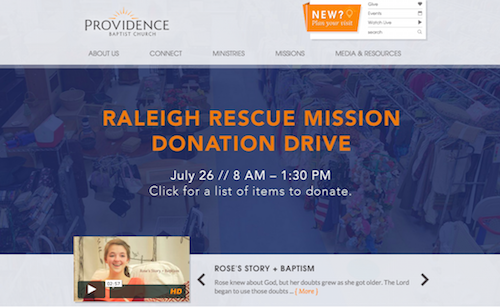
The Lord will guide you always;
he will satisfy your needs in a sun-scorched land
and will strengthen your frame.
You will be like a well-watered garden,
like a spring whose waters never fail.
Isaiah 58:11
You can’t plant a garden, ignore it all summer, and then expect an abundant harvest come September. Those seeds need water, weeding, fertilizer, trimming, and enough love to keep growing. Without tending and care, your poor, well-intentioned garden will be full of weeds and scattered around the unguarded plots.
A garden is a common metaphor for faith and life, but today, we’re talking about your website as a place to grow and tend to your community. Maybe we can think of your website as a greenhouse. You can promote it all you want, planting the idea to click over and pay a visit every now and again, but unless you really put mindful attention and effort into building and maintaining the church website, your good intentions won’t have the dependable, purposeful use you are praying for. Yes, a garden can thrive without a greenhouse, but in today's culture, it’s pretty tough for a church to thrive without a powerful, vibrant website.
These 3 practices will help you groom your website as a place for your community to grow and thrive––every day.
Keep your congregation active and help them grow using these three tips
1.) Direct the Church To It
The first step in gaining traffic to your website is to make the road run right through it. Engage your sermons, event registration, online giving, and even social media with the website, itself. The more available and approachable (even fun!) you make your website, the more you’ll entice visitors to come see what it’s all about. Make it an integral part of all of your processes and promotions so that it’s hard to miss. Link back to it in every online platform, and make it the hub for your church community. If you need to ask questions, like in a survey or registration form, host that on the website. After they’re done responding, direct them to an interesting or relevant part of the website that they may be interested in.
For example: You have a parent registering their child for VBS through a newsletter email they received. That email should direct them to the registration form on the website (you’ve gotten them in the door!), where they can complete it. After they finish the form, the site should display the message: “Thank you for registering! We look forward to seeing your family soon. See what your child will be learning:” and include a link to a blog post about the benefits of VBS for your child (make sure that that blog post points to the children’s ministry page for more general information, as well––always be writing with the next step in mind). Now that you’ve helped them see another point of interest, they will more easily engage with your site and be even more likely to return for additional information.
When anyone mentions your website in a sermon or an announcement, quickly explain how to find the information on the site. Don’t just say, “We offer online giving on our website.” Say, “You can join us in online giving in the “give” tab in the top navigation of our website.” If you use pre-service “billboard” slides, include your URL. And don’t forget to link to it in your newsletter and all email communications.
2.) Show Off Your Church
Your church website shouldn't just tell a story. It should tell many stories. Just like a garden isn’t all one kind of plant, you want to weave together a picture that reflects your congregation’s many gifts, talents, and personalities unifying around your common mission. Use videos to capture some of your members' personal journeys, featuring them on the homepage or in an "Our Members" page on your navigation. This will show that you care about the individuals in your congregation, and that you’re proud of the examples they are for your faith.
Think about how helpful and motivating this is for a visitor (or anyone, really). If you could see someone else being open and vulnerable, wouldn’t you be more likely to do that, as well? Wouldn’t you feel instantly more welcomed and receptive? Just walking through the door might be very difficult for some visitors. Connect them to real people right on your church website homepage, and you’re more likely to gain their trust.
Providence Baptist Church does a great job of this in its homepage rotator (and all throughout their site):

3.) Let the People Speak
Depending on the size of your church, you might not want to have a permanent "suggestions" box on your website. But you should ask for feedback at least somewhat regularly. Remind yourself what the greenhouse is for. You’re not really trying to build a wall of shiny windows, you’re trying to protect and nurture a great garden. It’s important to hear what your users like and feel most encouraged by in your church website.
It’s so easy to get caught up in the time and effort it takes to run a website––but focus groups, short, informal surveys, or just talking to people as you see them at events can help you better understand what you should and should not be doing online. What if you’re spending a great deal of time posting extra blog posts each week, but the real draw for your community is the sermon series? Now that you know this, you can refocus your efforts to build a stronger, more engaging sermon platform. The more often you take time to get feedback, the better your communication will be. It will help you prioritize your work in the church and possibly motivate and encourage the rest of the leadership team to help you continue to build an even better website.








